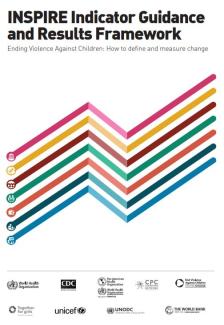
To help governments and organizations monitor uptake and results of INSPIRE strategies, and measure progress towards preventing and responding to violence against children, INSPIRE partners developed a core list of indicators (Chapter 3) and a results framework (Appendix A). The core indicators are designed to measure prevalence of violence, risk and protective factors, and the extent to which INSPIRE interventions have reached intended beneficiaries. INSPIRE partners, led by UNICEF, developed these indicators through a participatory process during 2016 and 2017 through multiple international meetings, conference calls and virtual consultations.
This introductory chapter is followed by Chapter 2, which discusses ethical issues to consider when gathering data on prevalence and risk factors related to violence against children. Chapter 3 presents the final list of core indicators agreed on by INSPIRE partner agencies. Chapter 4 includes a data sheet for each indicator, with information on the purpose of each indicator, data sources, operational definitions, sample measures, method of computation, links to online data (if available), limitations, suggested disaggregation and links to key international questionnaires (listed in Box 5 on page 26). Appendix A presents the full results framework. Appendix B provides sample questionnaire items from data sheets in a single, consolidated list for easy reference.
Levels of indicators
In accordance with the INSPIRE results framework, the core list of indicators is designed to track progress towards achieving results at three levels:
- The highest level (impact/goal level). The highest intended result of the INSPIRE package is to achieve meaningful change in the lives of children and adolescents. To monitor whether or not countries and communities are achieving this intended goal of reducing the prevalence of violence against children, the core list includes indicators for measuring the prevalence of a select number of key forms of violence against children and adolescents.
- Intermediate (outcome level). The core list also includes indicators designed to monitor intermediate (outcome level) results for each INSPIRE core strategy and activity. Typically, these results focus on evidence-based risk factors, protective factors and drivers of violence against children. Intermediate level indicators measure results such as changes in laws and policies, social norms, characteristics of community environments, institutional responses, and individual behaviours, awareness and skills of professionals, community members, caregivers, adolescents and children themselves.
- Shorter term, lower level (output level). Finally, the core list includes some indicators for measuring a smaller number of lower level changes, including the extent to which each INSPIRE strategy has been scaled up within countries and communities, as well as lower level steps in the results chain, such as changes in institutional capacity of key institutions, and coverage of certain types of programmes for families, caregivers and adolescents.
